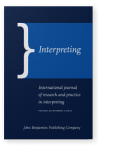Vol. 23:2 (2021) ► pp.168–191
The impact of visible lip movements on silent pauses in simultaneous interpreting
Simultaneous interpreting requires interpreters to listen to a source text while producing the target text in a second language. In addition, the interpreter needs to process various types of visual input, which may further increase the already high cognitive load. A study with 14 students of interpreting was conducted to investigate the impact of a speaker’s visible lip movements on cognitive load in simultaneous interpreting by analysing the duration of silent pauses in the target texts. Background noise masking the source speech was introduced as a control condition for cognitive load. Silent pause durations were shorter when interpreters saw the speaker’s lip movements, which indicates that interpreters benefitted from visual input. Furthermore, silent pause durations were longer with noise, which suggests that comparative silent pause durations can indicate changes in cognitive load.
Article outline
- 1.Introduction
- 2.Theoretical background
- 2.1Visual input in simultaneous interpreting
- 2.2Manipulating speech perception with background noise
- 2.3Disfluencies as an indicator of cognitive load
- 3.Empirical study
- 3.1Participants
- 3.2Material
- 3.3Procedure
- 3.4Data analysis
- 3.4.1Subjective reports
- 3.4.2Silent pause durations
- 3.5Results
- 3.5.1Subjective reports
- 3.5.2Silence durations
- 4.Discussion
- 4.1Limitations of the study
- 4.2Potential and limitations of silent pauses in the target text as cognitive load indicator
- 5.Conclusion
- Acknowledgements
- Notes
-
References
